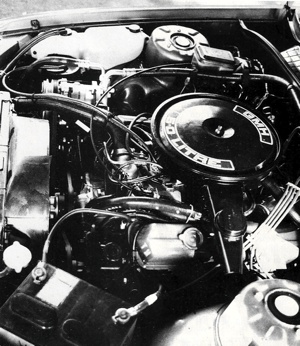|
Holden V8
|
Country: |
 |
 The Holden 5 Litre V8.
The Holden 5 Litre V8. |
The American 307
When the HK series was announced in 1968, a V8 was offered for the first time. This '307' was optional throughout the range, mandatorily coupled to the Powerglide automatic transmission. The 307 was an American-built Chevrolet engine. The compression ratio was 8.75:1 and it developed 210 bhp (158 kW) at 4600 rpm and 300 lb/ft (400 Nm) of torque at 2400 rpm.
Features included positive crankcase ventilation, an automatic choke, a five-main-bearing crankshaft and a Rochester 2-barrel carbie. The V8 was imported because the local one, which had been in development since 1964, was still not ready.
In GTS 327 form, the 2-door Monaro sports coupe offered the same 5.3-litre V8 engine and 4-speed gearbox as the Chevrolet Corvette. This had a red-coloured block with 4-barrel downdraft Rochester carburetor, chrome rocker covers, a massive chrome air cleaner and a low restriction exhaust system with twin pipes.
The Aussie V8, which made its public debut in the wildly extroverted Holden Hurricane (a 2-seater show car), was an advanced engine for its day, being quiet, torquey and easy-going. Furthermore it was available in all HT models. Until then all 'local' V8s (in Falcons, Valiants and Holdens) had been US-made. Holden had shown the way and in time the other members of the Big Three would be manufacturing or at least assembling V8s locally.
The All Aussie 253
The Holden V8's design and development was accomplished almost entirely by GM-H's Engineering Department. Six experimental engines were built for evaluation in 1966 and more than 500,000 road kilometres and 3500 hours of dynamometer testing were completed. The final result was the '253'. Named after its size in cubic inches, it allowed plenty of potential for future increases in displacement and power output. It displaced 4.146 litres and its good torque made the use of tall rear axles possible and gave a corresponding improvement in fuel consumption.
It was a short stroke engine with a nodular crankshaft, hydraulic lifters, roller chain crankshaft, cross-flow head and positive crankcase ventilation. The all-up weight, fan to flywheel, was 209 kg - only 36 kg heavier than the six and a figure Holden engineers were very proud of. Alloy cast iron was used for the block and aluminium was used for such parts as the rocker gear, water heated inlet manifold, timing cover, water pump and oil pump bodies to achieve this weight.
The Holden 308
Later a '308' version was announced. This was essentially an increased version of the 253 and gave 240 bhp (180 kW) at 4000 rpm and maximum torque of 315 ft/ lb (420 Nm) at 3000 rpm. It had a 9:1 compression ratio and a 4-barrel quadrajet carbie. Neither the 308 nor the imported 327 was the biggest engine seen in Holdens. A 5.74-litre Chevrolet '350' V8 was fitted to the 'Bathurst' model Monaro and later to other models. With a 10.25:1 compression ratio it developed 300 bhp (225 kW) at 4800 and produced 380 lb/ft (507 Nm) of torque at 3200 rpm. This gave the GTS 350 Monaro a top speed of 130 mph (210 km/h) and sub-16 second quarters.
The Aussie V8 went from strength to strength in the 1970s and early 1980s, powering thousands of road cars and giving Holden victory at Bathurst in 1975, 1976, 1978, 1979, 1980, 1982, 1983 and 1984. The last Bathurst victory for the carburetored V8 came in 1986 when Allan Grice powered his way to his first victory on the mountain.
Also see: The First All Aussie V8 | The Holden V6 | The Holden Grey Engine | The Holden Red Engine |



